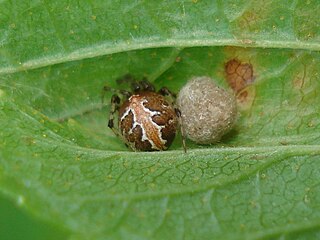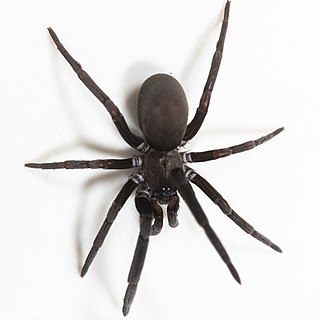
The Mygalomorphae, or mygalomorphs, are an infraorder of spiders. The name is derived from the Greek mygalē, meaning "shrew", plus morphē meaning form or shape. An older name for the group is Orthognatha, derived from the orientation of the fangs which point straight down and do not cross each other. In 1802, Charles Athanase Walckenaer separated mygalomorph spiders into a separate genus, Mygale, leaving all other spiders in Aranea.

Collinsia is a genus of about 20 species of annual flowering plants, consisting of the blue eyed Marys and the Chinese houses. It was traditionally placed in the snapdragon family Scrophulariaceae, but following recent research in molecular genetics, it has now been placed in a much enlarged family Plantaginaceae.

Collinsia heterophylla, known as purple Chinese houses or innocence, is a flowering plant native to California and the Peninsular Ranges in northern Baja California.

Cyatholipidae is a family of spiders first described by Eugène Simon in 1894. Most live in moist montane forest, though several species, including Scharffia rossi, live in dry savannah regions. They occur in Africa, including Madagascar, New Zealand and Australia, and one species in Jamaica. Most members of this family hang beneath sheet webs. Fossil species occur in the Eocene aged Bitterfield and Baltic Ambers, suggesting a wider geographic distribution in the past.

Macrothele is a genus of mygalomorph spiders in the family Macrothelidae, and was first described by A. Ausserer in 1871. It is the only genus in the family Macrothelidae, and most species occur in Asia, from India to Japan, and Java, with four found in Africa, and two in Europe. The name is derived from Ancient Greek μακρός ("makro-"), meaning "big", and θηλή ("thele"), referring to the spinnerets.

Collinsia parviflora is a species of flowering plant in the family Plantaginaceae known by the common names maiden blue eyed Mary and small-flowered collinsia.

Redrock Mountain Natural Area Preserve is a 640-acre (260 ha) Natural Area Preserve located in Smyth County, Virginia. The preserve is named for the 4,413-foot (1,345 m) Redrock Mountain, which itself is named for its red siltstone cliffs. It supports a number of rare natural features, and two natural community types, including examples of "mountain/piedmont basic woodlands" upon the mountain's slopes, and "rich cove/slope forests" in the preserve's lowlands. Five rare plant species are found on the property, including spring blue-eyed Mary, fringed scorpion-weed, and Carey saxifrage.

Xestobium is a genus of death-watch and spider beetles in the family Ptinidae. There are about 13 described species in Xestobium.
Michael Gordon Rix is an Australian arachnologist, whose publications mainly concern spiders.
Collinsia is a genus of dwarf spiders that was first described by Octavius Pickard-Cambridge in 1913.
Collinsia plumosa is a species of dwarf spider in the family Linyphiidae. It is found in the United States and Canada.
Zygiella dispar is a species of orb weaver in the family of spiders known as Araneidae.
Eulonchus marginatus is a species of small-headed flies in the family Acroceridae.

Theridion pictum is a species of cobweb spider in the family Theridiidae. It is found in the United States, Canada, Europe, and Turkey. It is the type species of the genus Theridion.
Elaver excepta is a species of sac spider in the family Clubionidae. It is found in North America and the Caribbean.
Grammonota vittata is a species of dwarf spider in the family Linyphiidae. It is found in the United States.
Hyptiotes puebla is a species of cribellate orb weaver in the family of spiders known as Uloboridae. It is found in the United States and Mexico.

Kukulcania geophila is a species of crevice weaver in the family of spiders known as Filistatidae. It is found in the United States and Mexico.

Synemosyna formica, is an ant-mimicking jumping spider in the family Salticidae. It is found in the eastern United States and parts of Canada.

Mecaphesa asperata, the northern crab spider, is a species of crab spider in the family Thomisidae, found in North and Central America, and the Caribbean. It is a species of the 'flower spiders', so-called because they generally hunt in similarly coloured flowers for visitors such as bees and flies, and is a much smaller nearctic relative of the better-known Goldenrod Spider.











